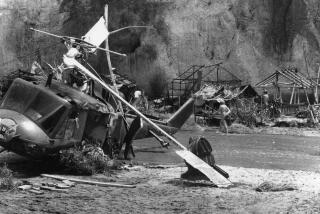Safety Lapses Probed in Copter Crash
- Share via
VAN NUYS — Basic flight safety measures were being ignored when a helicopter crashed in the desert Tuesday while making a low-level run for a tool company commercial, killing the co-pilot, government officials and veteran fliers said Thursday.
The crash is being investigated by the Federal Aviation Administration, the National Transportation Safety Board and the quasi-governmental agency that administers film location shooting in the Los Angeles area--the Entertainment Industry Development Corp./L.A. Film Office.
Also, the Los Angeles County district attorney’s office, which is automatically called in when there is a death on the job, launched an investigation. Some such cases have led to manslaughter convictions, a spokeswoman for the district attorney said.
The Film Office earlier suspended issuance of location filming permits to Propaganda Films, the company that hired the copter, while it investigates the company’s lack of proper permits.
Use of the helicopter--for a scene in which it chased a jeep over rocky slopes at low altitude--should have been cleared with the FAA and approved on the Film Office permit, officials of those agencies said.
NTSB investigators said they also suspect co-pilot Michael Tamburro--who was killed--may not have been wearing a harness or fastened helmet when the chopper, a former Army AH-1 Cobra attack helicopter, crashed outside Lancaster.
It is an allegation some of Tamburro’s close associates found hard to believe.
Wearing a shoulder harness is so basic it’s considered “common sense” for helicopter pilots, said Kevin La Rosa, owner of Jetcopters in Van Nuys.
The FAA doesn’t specifically require that pilots wear helmets and harnesses, but the Army--for which the Cobra was designed and which has the most experience with them--does. Cobra pilots are required to wear them “without exception,” said Bill Hayes, a public information officer with the U.S. Army’s Aviation Center in Fort Rucker, Ala.
Although failing to use a harness or helmet is not illegal by itself, the FAA may take it into account as a possible safety lapse in its determination of possible penalties against the pilots and the firm, said FAA spokesman Mitch Barker.
KCBS-TV reported Thursday that the company that owned the helicopter, Van Nuys Airport-based West Coast Helicopters, has had two previous in-flight mishaps that resulted in hard landings. A spokesman for the firm confirmed that one such incident took place in the last year, but said it was not serious.
“Everyone walked away,” said David Corsello, a spokesman for West Coast. “It was just something that sometimes happens.” He knew of no other mishaps, he said.
Corsello added that he, too, was puzzled by the reports that Tamburro--whom he described as a close friend--might have neglected to use a harness and helmet. That would have been unusual for Tamburro, a pilot who was “safe to an extreme,” Corsello said.
Asked why Tamburro was flying without FAA approval, Corsello declined to comment. Nor would he say whether West Coast routinely notifies the FAA of its film work.
Representatives of Propaganda Films met Thursday with officials of the Film Office, said office spokesman Michael Bobenko. The film company said that its failure to get a permit for the helicopter flight was “an oversight” and agreed to submit a written plan for avoiding such problems, Bobenko said.
The office will then decide whether to take further action against Propaganda, he said.
“They are now very aware of how serious a failing it is not to let us know about helicopter work,” said Bobenko. “They are on hold until we can be assured this type of incident won’t happen again.”
The Film Office was sufficiently concerned about film crews using low-flying helicopters to institute a new set of rules four months ago.
The office now requires the FAA to review and approve flight plans for aircraft used on movie sets before it will issue permits to a film crew. Had Propaganda obeyed the rules, the FAA would have had a chance to check the plans for safety lapses prior to the accident, Bobenko said.
More to Read
Sign up for Essential California
The most important California stories and recommendations in your inbox every morning.
You may occasionally receive promotional content from the Los Angeles Times.













